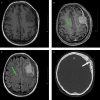Meningioma in the elderly
- PMID: 37287581
- PMCID: PMC10243852
- DOI: 10.1093/noajnl/vdac107
Meningioma in the elderly
Abstract
Meningiomas are the most common primary intracranial neoplasm, accounting for approximately 40% of all primary brain tumors. The incidence of meningioma increases with age to 50 per 100,000 in patients older than 85. As the population ages, an increasing proportion of meningioma patients are elderly. Much of this increase is accounted for by an increase in incidental, asymptomatic diagnoses, which have a low risk of progression in the elderly. The first-line treatment of symptomatic disease is resection. Fractionated radiotherapy (RT) or stereotactic radiosurgery (SRS) can be considered as primary treatment where surgery is not feasible, or as adjuvant therapy in cases of subtotal resection or high grade histopathology. The role of RT/SRS, particularly following gross total resection of atypical meningioma, is unclear and requires further evaluation. There is an increased risk of perioperative and postoperative morbidity in the elderly and therefore management decisions must be tailored to individual circumstances. Good functional outcomes can be achieved in selected patients and age alone is not a contraindication to intervention. The immediate postoperative course is an important determinant of prognosis. Therefore, careful preoperative evaluation and avoidance of complications are necessary to optimize outcomes.
Keywords: elderly; geriatric; meningioma; radiotherapy; surgery.
© The Author(s) 2023. Published by Oxford University Press, the Society for Neuro-Oncology and the European Association of Neuro-Oncology.
Figures




References
-
- Cea-Soriano L, Wallander MA, Garca Rodrguez LA. Epidemiology of meningioma in the United Kingdom. Neuroepidemiology 2012;39(1):27–34. - PubMed
LinkOut - more resources
Full Text Sources
Research Materials
